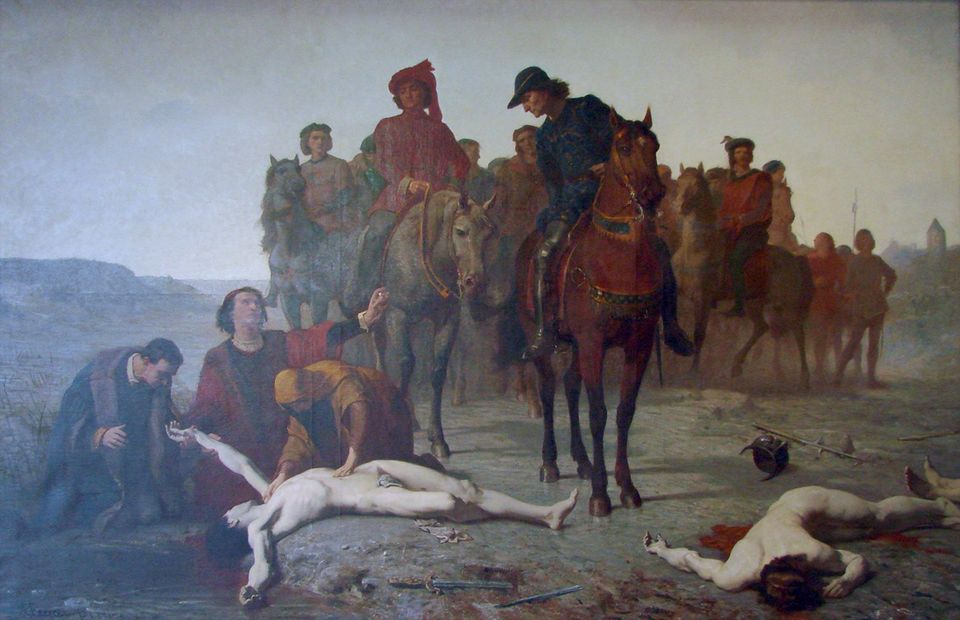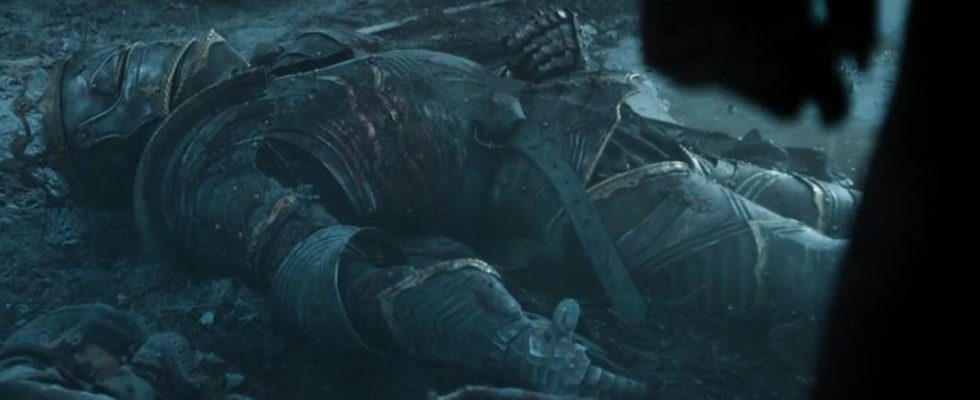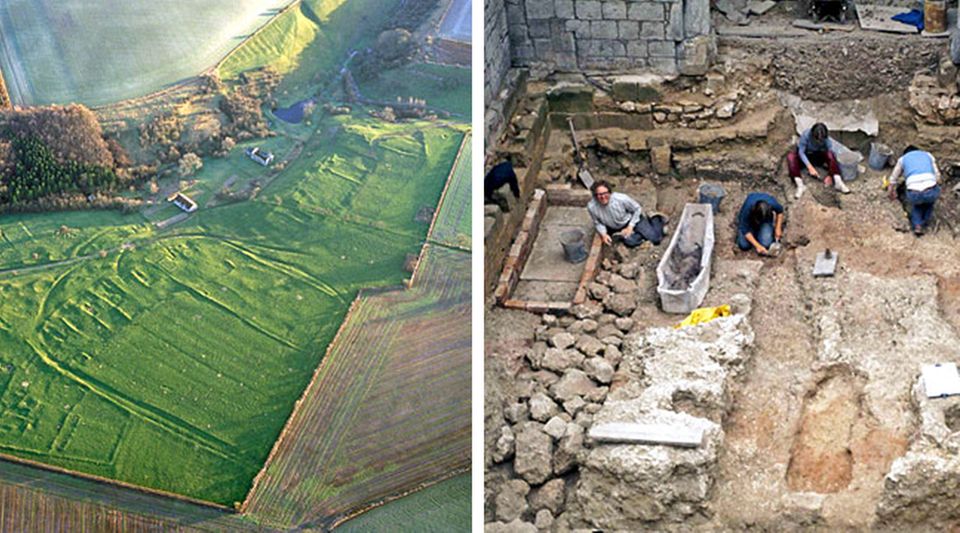Many believe that the knights were defeated by firearms. That is not right. The magnificent Duke of Burgundy led the best knightly army of his time against Switzerland. The flower of knighthood and his army were literally hacked to pieces.
On horseback, with helmet, armor – full of shine and full of colors. This is how the knight survived in the collective memory. The proudest and most brilliant knight was Charles le Téméraire, Charles the Bold, the immensely rich Duke of Burgundy. And of all people, he, the flower of knighthood, was defeated by Swiss farmers in three battles. All that was left of the proud Burgundian was the counting rhyme: “At Grandson he lost the estate, at Murten he lost his courage, at Nancy he lost his blood.”
“I dared”
Charles died in 1477 as he had lived, without any fear. His motto is: “I dared” – “Je lay emprins”. And now he had lost everything. Two days after his last fight, the body was found near a pond. A blow from the halberd had split his head in half. He was disfigured by further injuries, eaten by wolves and stripped of all signs of his power. Karl’s corpse was frozen and naked – the dead man had been completely looted. Only an old servant could identify the Duke from old hubs.

The body of Charles the Bold is found. The painter Auguste Feyen-Perrin idealized the dead man; in fact, the splendor-loving prince was completely disfigured.
© Commons / Manufacturer
An inglorious end not only for Charles, but also for knighthood as a military power. Because Charles’s heavy, armored cavalry could not stand against the array of Swiss farmers. It is a popular myth that firearms defeated the knight, it was a completely different weapon, now forgotten.
Only win with a terrain advantage
Even before this, levies had managed to defeat large armies of knights. The Swiss won their independence when they defeated the Habsburgs at Morgarten (1315) and Sempach (1386), in In Germany, the fighters of the Dithmarscher Peasants’ Republic defeated the mercenaries of the Black Guard in 1500. But the terrain played a crucial role in all of these victories. The untrained farmers and citizens managed to put the armored professional warriors to fight in a place where their heavy armor was not an advantage but a serious disadvantage.
In the fight against Charles the Bold, swamps and slopes did not come to the aid of the Confederates. Here the Swiss “invented” modern infantry. The Romans already knew that horsemen could not break through a line of foot soldiers unless they panicked. But the Roman legionnaires were trained fighting machines who had practiced combat in their formations for years.
A very long spear was the super weapon
The Swiss contingents did not consist of professional soldiers – they were strong and brave, but not particularly disciplined. The Swiss had another advantage: They did not use converted scythes and short skewers like other peasant levies. The Swiss developed a long pike that was longer than the knights’ lances. These spears were about 5 meters long and could only be controlled by strong men. They were weapons that could only be used in a group; they were completely unsuitable for man-to-man combat. But in a large formation they were a terrible weapon.
Charles the Bold, on the other hand, had the most modern army of his time. His heavy cavalry fought in a disciplined manner under one command, he had artillery and efficient supplies in the field. The Swiss lined up in large rectangular piles, the narrower side forming the front. She was brimming with weapons as the first rows of the pile lowered the gigantic pikes. There was no counterattack against this front on horseback. Before the knight’s sword or lance could reach a foot warrior, he and his horse would have been impaled. A violent attack as a breakthrough was also impossible. If the rear side of the long spear was supported in the ground, the wall of lances was impenetrable.
The biggest innovation: The Swiss formation wasn’t just capable of defense. Even the Hussite wagon forts, which were chained together, could hardly or only with great difficulty be broken open by armies of knights, but they were immobile. The Swiss bunch, on the other hand, was an unstoppable attack formation that shattered enemy lines like Thor’s hammer.
Horrible slaughter
The reason was simple and cruel: once the deep formation got moving, it could no longer hold. The front ranks had to advance incessantly because the rear ranks were pushing forward. Anyone who sank to the ground was trampled underfoot by their own people. With this force, the lance forest of the front pushed forward and crushed all resistance. At the front of the group were the pikemen with lances, followed by fighters with halberds and two-handed swords, and then there were armored fighters. The knight had no chance against this kind of fighting. You could only counter a violent mob with your own formation of the same type. The Germans quickly adapted the Swiss method of warfare.
The German mercenary leader Frundsberg described the clash between two groups in Italy as follows: “Where a number of members perish under the long defenses, the people behind them become a little timid.” The long skewers got caught and the crowd was worse than in a concert in front of the stage. Swords and halberds were of no use, so in tight quarters people resorted to daggers, short axes and fist hammers. Many were simply crushed. Others crawled between the legs to cut the opponent’s tendons. The carnage continued until a heap began to stagger. But escape was not an option, the group, unable to hold out any longer, was literally rammed into the ground.
Beginning of Swiss neutrality
For the Swiss themselves, leadership in military technology proved to be a mixed blessing. Through them, Swiss independence was preserved. Switzerland expanded its territory significantly through conquests in what is now Germany and Italy. Until Napoleon, no one dared to attack the Confederates. But the Swiss soon suffered their first defeat. At Marignano they were thrown back by German, French and Italian mercenaries who fought just like them, but with more discipline. The Battle of Marignano was extraordinarily cruel. Contemporary witnesses reported that the fighters were up to their ankles in the blood of the dead.
Today the battle is forgotten everywhere in the world, except in Switzerland. There, the “Battle of the Giants” is seen as a turning point in foreign policy. Switzerland’s strict neutrality policy is attributed to the shock of the defeat.
At that time the world was horrified by the barbaric and cultic savagery of the fighting. In the battles against Charles the Bold, the Swiss were strictly forbidden to take prisoners. In the Middle Ages, prisoners were taken for ransom, the Swiss were supposed to fight in formation and not abandon them for a ransom. The result: They mercilessly beat all prisoners and injured people to death. In Marignano, the Germans cut open the bellies of dead Swiss people in order to grease their skewers with the fat. Until the Enlightenment, corpse fat had a strong cultic significance in popular belief. They chopped up other corpses to fry and eat the parts.
Beginning of the Swiss Guard
After the defeat, the Swiss authorities restricted “rice running” – the Swiss term for mercenary work. One of the last and most famous rice runners was Kaspar Röist. He and his men founded the tradition of the Swiss Guard in the Vatican when they protected the Roman Pope from Spanish mercenaries in 1527. The Spaniards were Catholic, while Röist and his men were Reformed.
Although they were supposed to return to Zurich, the Swiss mercenaries, as “true men of war and servants,” did not want to abandon the Pope and the College of Cardinals “in their great need.” Röist and most of his men stopped the attackers in St. Peter’s Square, and 42 mercenaries led by Hercules Göldli were able to bring the Pope to safety. All the remaining Swiss fell. The seriously injured Kaspar Röist was hacked to pieces. His wife lost her fingers while throwing herself protectively over the dying man.
literature
“Charles the Bold. The End of the House of Burgundy.” Werner Paravicini
“The war history of the Swiss: from the founding of the Swiss Confederation to eternal peace with France. M. Rudolf” Google Books
“Historia Mr. Georgen and Mr. Casparn von Frundsberg, Fathers and Sons, both Mr. zu Mündelheym, Keyserlich Supreme General, Knightly and Commendable War Deeds” Google Books


